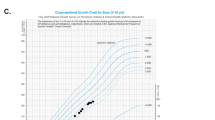Summary
We describe an Ashkenazi Jewish family in which two adults, offspring of consanguineous parents, have persistent hypertyrosinaemia (770–1110 µmol/L; normal < 110 µmol/L). The metabolic disorder in this family is apparently due to hepatic cytosolic tyrosine aminotransferase deficiency (hereditary tyrosinaemia, type II; McKusick, 276600), because it is associated with the oculocutaneous manifestations of Richner-Hanhart syndrome. The association of this syndrome with hereditary tyrosinaemia type II is presumed to be constant. It is not in this family. The affected female sib (age 41 years) has hypertyrosinaemia and oculocutaneous signs; the brother (age 39 years) has hypertyrosinaemia but no oculocutaneous disease. Both sibs have two children; none has signs of a metabolic fetopathy. Maternal hypertyrosinaemia and maternal hyperphenylalaninaemia evidently constitute different risk factors for the fetus. Paternal hypertyrosinaemia is apparently not a risk to male infertility.
Similar content being viewed by others
References
Bardelli AM, Borgogni P, Farnetani MA et al (1977) Familial tyrosinaemia with eye and skin lesions: presentation of two cases.Ophthalmologica 175: 5–9
Bonhert A, Anton-Lamprecht I (1982) Richner-Hanhart's syndrome: ultrastructural abnormalities of epidermal keratinization indicating a causal relationship to high intracellular tyrosine levels.J Invest Dermatol 79: 68–74
De Marchi S, Cecchin E, Basile A et al (1984) Close genetic linkage between HLA and renal glycosuria.Am J Nephrol 4: 280–286
Endo F, Kitano A, Uehara, I et al (1983) 4-Hydroxyphenylpyruvic acid oxidase deficiency with normal fumarylacetoacetase: a new variant form of hereditary hypertyrosinemia.Pediatr Res 17: 92–96
Fellman JH, Vanbellinghen PJ, Jones RT, Koler RD (1969) Soluble and mitochondrial forms of tyrosine aminotransferase: relationship to human tyrosinemia.Biochemistry 8: 615–622
Fois A, Borgogni P, Cioni M et al (1986) Presentation of the data of the Italian registry of oculocutaneous tyrosinemia.J Inher Metab Dis 9: 262–264
Garibaldi LR, Durand P (1980) Soluble tyrosine amino-transferase (STAT) deficiency tyrosinemia.Pediatr Res 14: 1428
Garibaldi LR, Siliato F, De Martini I, Scarsi MR, Romano C (1977) Oculocutaneos tyrosinosis: report of two cases in the same family.Helv Paediatr Acta 32: 173–180
Garibaldi L, Pregliasco P, Romano C, Siliato F, Durand P (1979) La tirosinosi oculocutanea. Un problema italiano?Med Surg Pediatr 1: 279–284
Gibbs BF, Itiaba K, Crawhall JC, Mamer OA (1973) A rapid gas chromatographic method for the quantitation of volatile fatty acids in urine.J Chromatogr 81: 65–69
Goldsmith LA, Laberg C (1989) Tyrosinemia and related disorders. In Scriver CR, Beaudet AL, Sly WS, Valle D eds.The Metabolic Basis of Inherited Disease, 6th edn. New York: McGraw-Hill, 547–554
Hanhart E (1947) Neue Sonderformen von keratosis palmo-plantaris, u.a. eine regelmaessig dominante mit systematisierten lipomen, ferner 2 einfachrezessive mit Schwachsinn und z.T. mit Hornhautveranderungen des Auges (Ektodermatosyndrom).Dermatologica 94: 286–308
Hunziker N (1980) Richner-Hanhart syndrome and tyrosinemia type II.Dermatologica 160: 180–189
Kennaway NG, Buist NRM (1971) Metabolic studies in a patient with hepatic cytosol tyrosine aminotransferase deficiency.Pediatr Res 5: 287–297
Kronick JB, Mamer OA, Montgomery J, Scriver CR (1983) Apparent gastrointestinal origin ofcis-4-hydroxycyclohexanecarboxylic acid.Clin Chim Acta 132: 205–208
Lenke RR, Levy HL (1980) Maternal phenylketonuria and hyperphenylalaninemia.N Engl J Med,303: 1202–1208
Levy HL, Lobbregt D, Koch R, de la Cruz F (1991) Paternal phenylketonuria.J Pediatr 118: 741–743
Mamer OA, Montgomery JA, Colle E (1980) Profiles in altered metabolism: III (Ω-1)-Hydroxyacid excretion in a case of episodic hypoglycemia.Biomed Mass Spectrom 7: 53–57
Mamunes P, Prince P, Thornton NH, Hunt PA, Hitchcock ES (1976) Intellectual deficits after transient tyrosinemia in the term neonate.Pediatrics 57: 675–680
Natt E, Kida K, Odievre M, DiRocco M, Scherer G (1991) Point mutations in the tyrosine aminotransferase gene in tyrosinemia type II.Am J Hum Genet 49 (4 Suppl.: 104
Partington MW, Campbell D, Kuyek J, Mehlomakulu M (1971) Motor activity in early life. III. Premature babies with neonatal tyrosinaemia; a pilot study.Biol Neonate 18: 121–128
Rehák A, Selim MM, Yadav G (1981) Richner-Hanhart syndrome (tyrosinemia II); report of four cases without ocular involvement.Br J Dermatol 104: 469–475
Richner H (1938) Hornhautaffektion bei Keratoma palmare et plantare hereditarium.Klin Monatsol Augenh 100: 580–588
Waardenburg PJ, Fraceschetti A, Klein D (1962)Genetics and Ophthalmology, vol. I. Springfield, Ill: Charles C. Thomas, 515–517
Westphal E-M, Natt E, Grimm T, Odievre M, Scherer G (1988) The human tyrosine aminotransferase gene: characterization of restriction fragment length polymorphism and haplotype analysis in a family with tyrosinemia type II.Hum Genet 79: 260–264
Author information
Authors and Affiliations
Rights and permissions
About this article
Cite this article
Chitayat, D., Balbul, A., Hani, V. et al. Hereditary tyrosinaemia type II in a consanguineous Ashkenazi Jewish family: Intrafamilial variation in phenotype; absence of parental phenotype effects on the fetus. J Inherit Metab Dis 15, 198–203 (1992). https://doi.org/10.1007/BF01799631
Received:
Accepted:
Issue Date:
DOI: https://doi.org/10.1007/BF01799631




